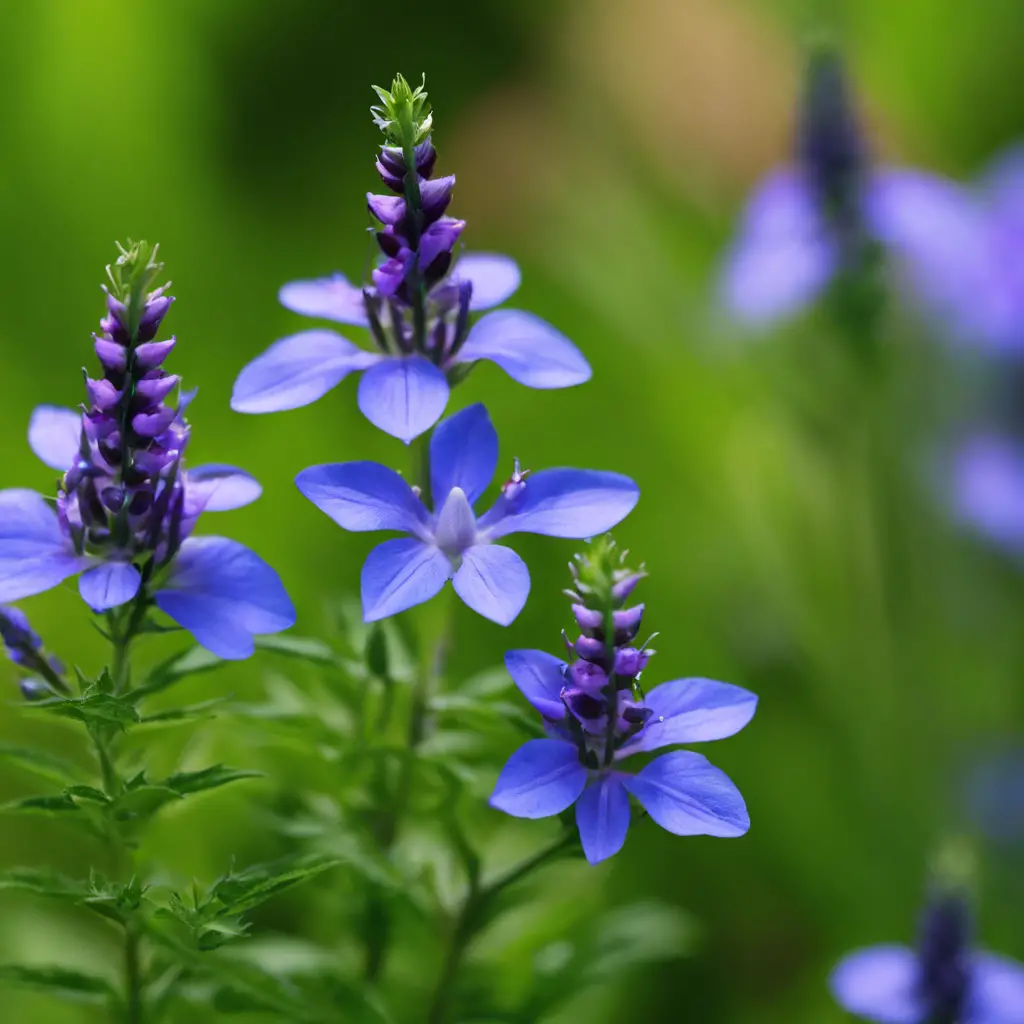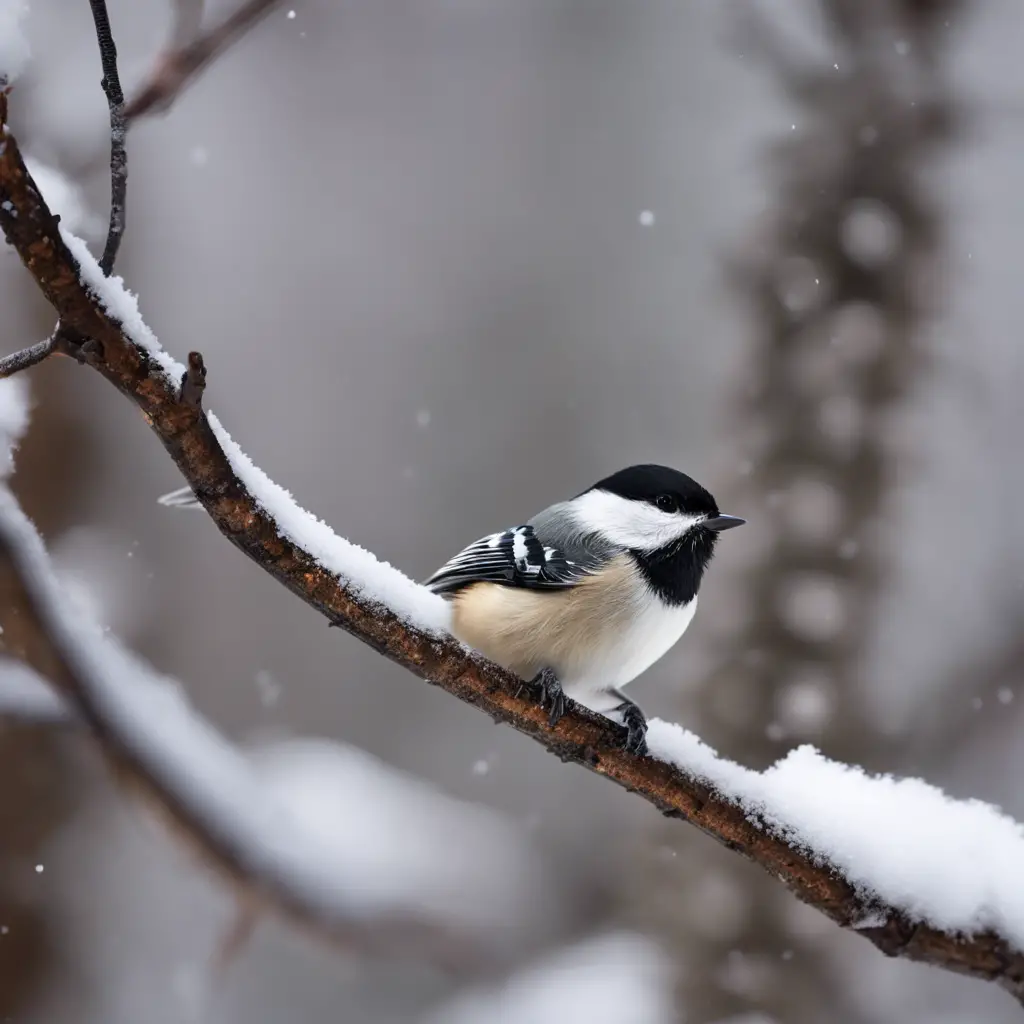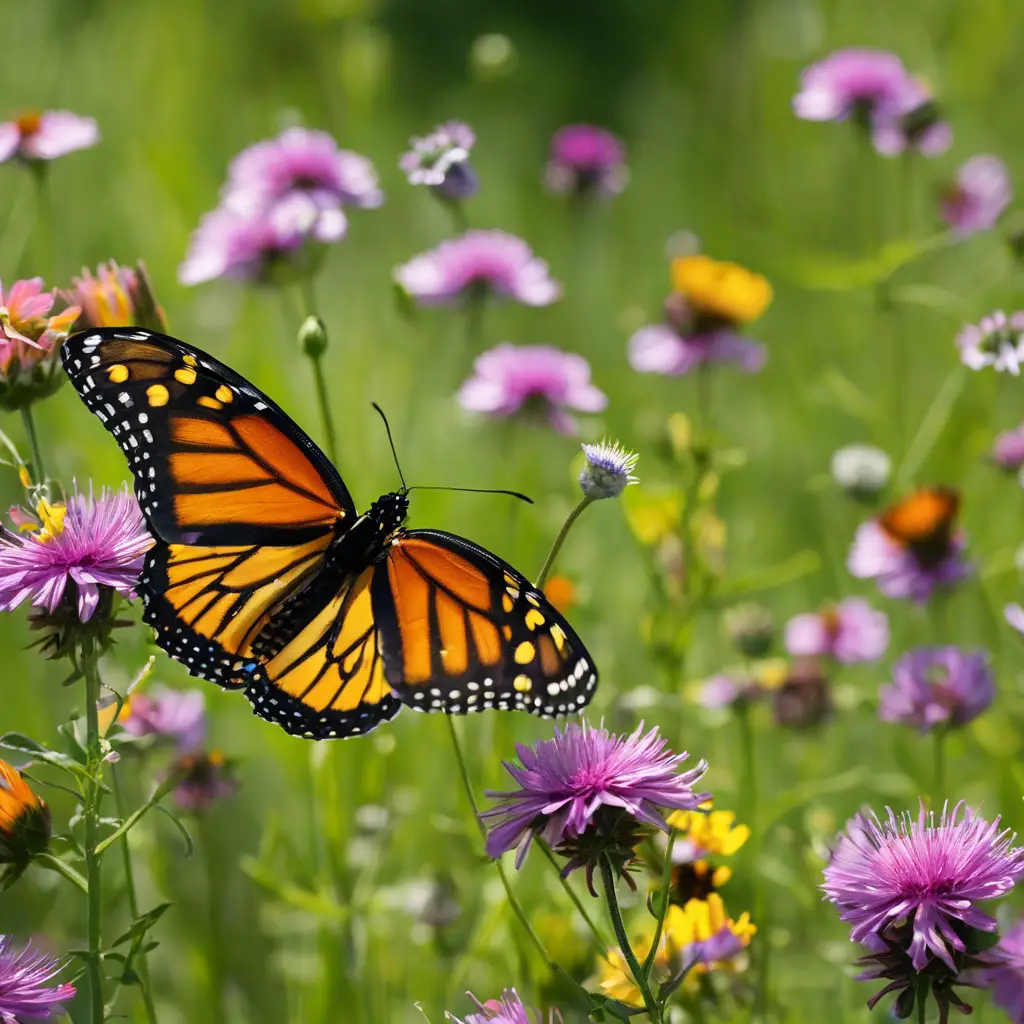Welcome to the fascinating world of birds in New York!
In this article, you’ll discover the diverse avian species that call this state home.
From the vibrant American Robin and the playful Blue Jay, to the charming Black-capped Chickadee and the majestic Wood Duck, New York offers a haven for bird enthusiasts.
Get ready to explore the captivating lives of these feathered creatures as they soar through the skies and grace the landscapes of the Empire State.
Key Takeaways
- The American Robin and Black-capped Chickadee are commonly found in forests, woodlands, parks, and suburban areas of New York.
- The Blue Jay is known for its distinctive blue crest and black markings, and can be found in forested areas, suburban, and urban environments.
- The Carolina Wren is known for its melodious calls and vibrant plumage, and prefers dense shrubs, thickets, and woodland edges.
- The Eastern Bluebird is a cavity nester and prefers open habitats with scattered trees, such as meadows and farmlands.
American Robin

You should definitely check out the American Robin, it’s a common bird species found in New York.
The American Robin, scientifically known as Turdus migratorius, is a medium-sized songbird known for its distinctive orange-red breast and grayish-brown upperparts.
This species is widely distributed across North America, including New York, where it can be found in a variety of habitats such as forests, woodlands, parks, and suburban areas.
The American Robin has specific habitat preferences, favoring areas with open lawns and scattered trees, where it can easily forage for earthworms, insects, and berries.
It’s a migratory bird, typically breeding in the northern regions and wintering in the southern states.
During the breeding season, male American Robins establish territories and sing melodious songs to attract mates.
They build cup-shaped nests made of mud, grass, and twigs, usually located in trees or shrubs.
The female lays a clutch of 3-5 blue eggs which she incubates for about two weeks.
The American Robin is an interesting bird to observe, especially during its breeding behavior, as it displays fascinating territorial displays and intricate nest building techniques.
Black-capped Chickadee

Take a closer look at the Black-capped Chickadee, a small passerine bird known for its distinctive black cap and white cheeks. This charming little bird can be found throughout North America, including in the forests and woodlands of New York.
Here are three fascinating facts about the black-capped chickadee:
Breeding habits: Black-capped chickadees typically form monogamous pairs during the breeding season. They excavate cavities in dead trees or use natural tree cavities as their nesting sites. The female builds the nest using moss, bark, and other soft materials, while the male guards the territory.
Diet and feeding behavior: These birds have a varied diet, consisting mainly of insects, spiders, berries, seeds, and even small vertebrates. They’re known for their ability to cache food, storing it in various locations and relying on their excellent memory to retrieve it later.
Vocalizations: Black-capped chickadees are highly vocal birds and have a wide array of calls. Their most famous call is the ‘chick-a-dee-dee-dee’ song, which they use to communicate with each other and establish their territory.
The black-capped chickadee’s breeding habits, diet, and feeding behavior make it an intriguing species to study. By understanding these aspects of their behavior, researchers can gain valuable insights into their ecology and conservation.
Blue Jay

Don’t forget to keep an eye out for the Blue Jay, as it is not only a stunning bird but also known for its distinctive blue crest and black markings. The Blue Jay, scientifically known as Cyanocitta cristata, is a common bird found in North America, including New York. It is known for its behavior patterns and habitat preferences. Let’s take a closer look at these aspects in the table below:
| Behavior Patterns | Habitat Preferences |
|---|---|
| Highly vocal | Forested areas |
| Aggressive towards predators | Suburban and urban areas |
| Omnivorous diet | Open woodlands |
| Caches food for later use | Parks and gardens |
| Monogamous breeding | Backyard bird feeders |
| Migratory | Nest in trees |
Blue Jays are highly vocal birds, known for their loud calls and mimicry of other bird species. They are also territorial and can be aggressive towards predators. In terms of habitat preferences, they are commonly found in forested areas, but have adapted well to suburban and urban environments. Blue Jays have an omnivorous diet, feeding on a variety of insects, fruits, seeds, and even small vertebrates. They are known to cache food for later use. During breeding season, Blue Jays are monogamous and build their nests in trees. They are also migratory birds, with some populations traveling long distances. Keep an eye out for these beautiful birds in your backyard or local parks!
Canada Goose
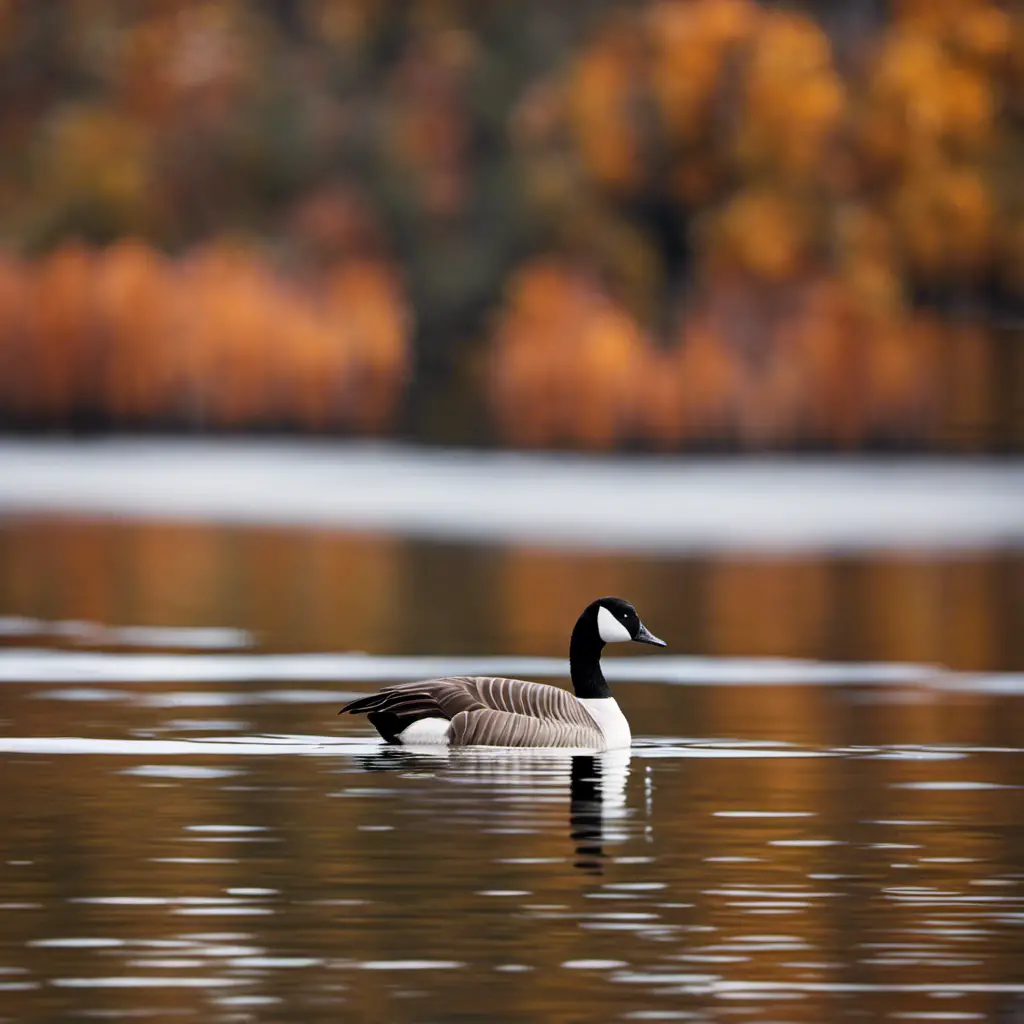
Look out for the Canada Goose, as it’s a common sight in parks and lakes across North America. These majestic birds have fascinating breeding habits and migration patterns that are worth exploring.
Here are three key facts about Canada Goose that will evoke a sense of wonder and appreciation:
Breeding Habits: Canada Geese usually mate for life and return to the same nesting sites year after year. The female builds the nest on the ground using grass and feathers, while the male stands guard nearby. They lay an average of 5-6 eggs and both parents take turns incubating them.
Migration Patterns: Canada Geese are known for their long-distance migrations. They travel in V-shaped formations, taking advantage of the air currents to conserve energy. They can fly thousands of miles to reach their wintering grounds, often returning to their breeding grounds in the spring.
Common Predators: While Canada Geese are large and powerful birds, they still face threats from predators. Some of their common predators include foxes, coyotes, raccoons, and large birds of prey like eagles and owls.
Understanding the breeding habits and migration patterns of Canada Geese, as well as their interactions with predators, can deepen our appreciation for these remarkable birds. So, next time you spot a Canada Goose, take a moment to marvel at their incredible journey and resilience in the face of challenges.
Carolina Wren
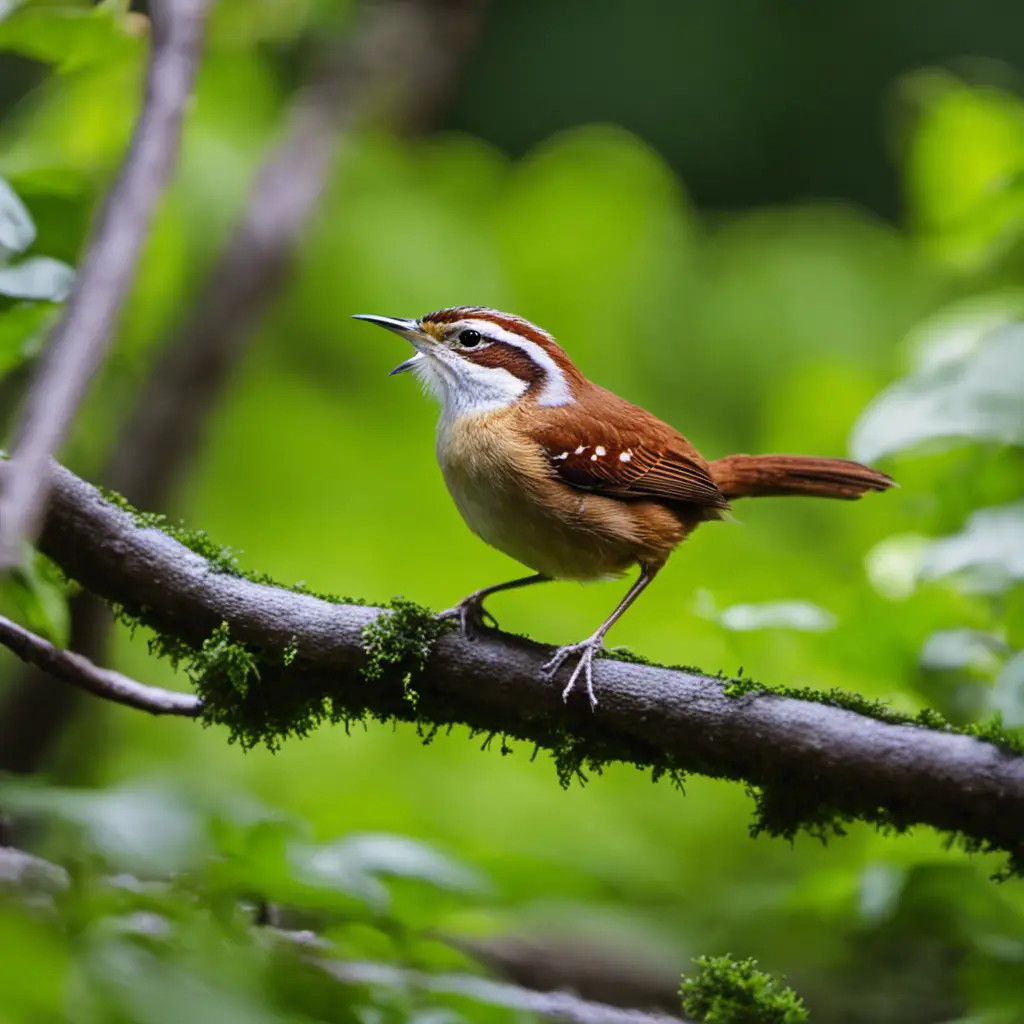
You can appreciate the beautiful songs of the Carolina Wren, as they’re known for their melodious calls and can sing up to 25 different tunes.
This small bird, scientifically known as Thryothorus ludovicianus, is native to the eastern parts of the United States.
The Carolina Wren displays interesting behavioral patterns, such as its habit of vigorously defending its territory and nest. It’s a curious and active bird, often seen hopping around on the ground or perched on low branches, searching for insects and spiders to feed on.
In terms of habitat preferences, the Carolina Wren is typically found in dense shrubs, thickets, and woodland edges. It also has a tendency to build nests in various locations, including birdhouses, tree cavities, and even potted plants.
Overall, this delightful bird showcases fascinating behavioral patterns and adapts well to a variety of habitats.
Common Grackle

Take a look at the Common Grackle, as it’s a large blackbird with a shiny blueish-green iridescent plumage, commonly found in urban areas across North America. This species is known for its unique migration patterns and nesting habits.
Here are three fascinating facts about the Common Grackle:
Migration patterns: Common Grackles are highly migratory birds, traveling long distances each year. They’ve been observed to migrate in flocks that can number in the thousands. These flocks move in a synchronized manner, creating a mesmerizing spectacle in the sky.
Nesting habits: Common Grackles build their nests in a variety of locations, including trees, shrubs, and even man-made structures. They construct their nests using twigs, grass, and mud. These nests are often large and bulky, providing a secure space for their eggs and chicks.
Urban adaptability: Unlike many bird species, Common Grackles have successfully adapted to urban environments. They’re frequently seen in parks, gardens, and residential areas, making them a familiar sight to city dwellers.
Understanding the migration patterns and nesting habits of the Common Grackle sheds light on the remarkable adaptability and behavior of these urban birds.
Dark-eyed Junco

Have you seen a Dark-eyed Junco, or do you know where they’re commonly found in New York?
Dark-eyed Juncos, scientifically known as Junco hyemalis, are small-sized sparrows that inhabit various regions across North America. In New York, these birds are commonly found during the winter months, particularly in forested areas and suburban gardens.
Dark-eyed Juncos exhibit interesting behavioral patterns, often forming large flocks that forage together on the ground. They’re primarily seed-eaters, but they also consume insects and berries when available.
Their preferred habitats include coniferous and mixed forests, as well as shrubby areas with dense vegetation. These birds are known for their distinctive appearance, with dark-gray or black heads, white bellies, and white outer tail feathers that flash when they fly.
Downy Woodpecker
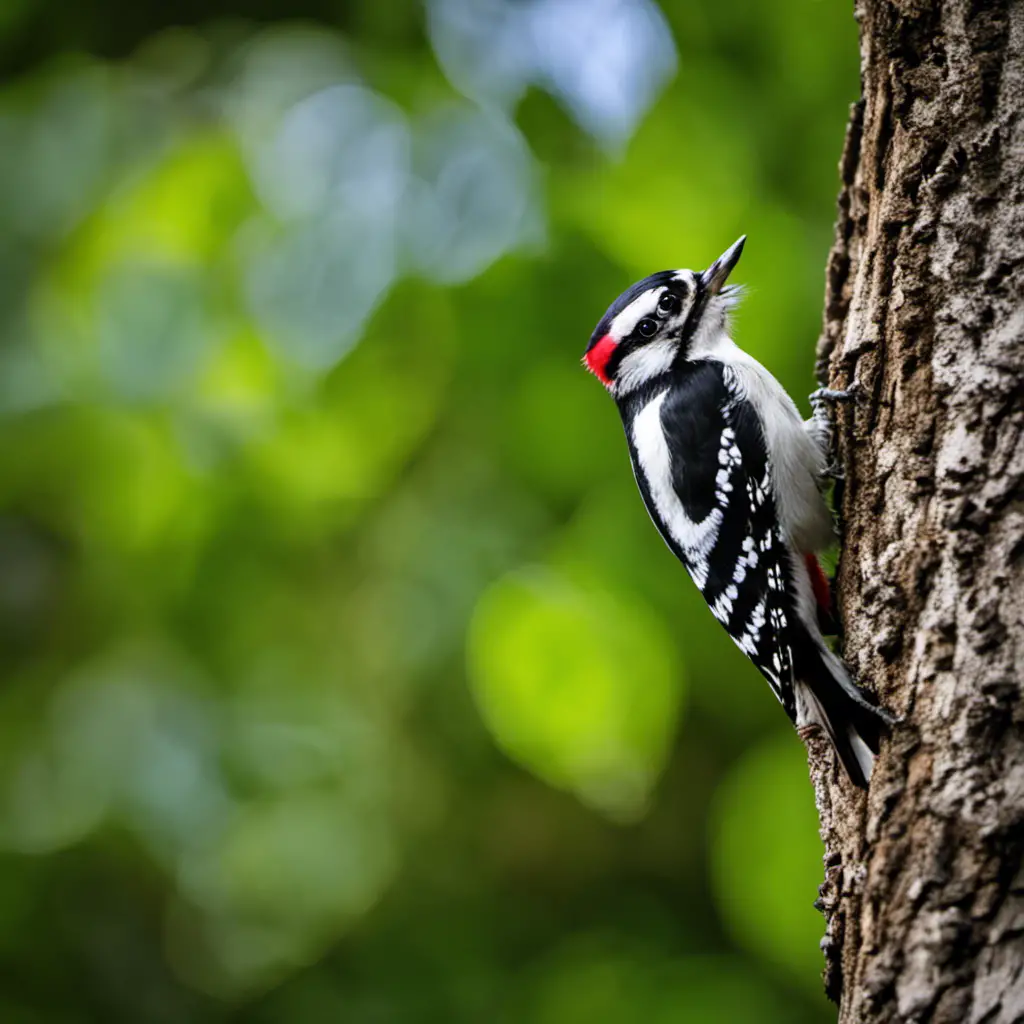
If you look closely, you can spot the Downy Woodpecker in your backyard or local parks, for they’re known to frequent these areas. This small but striking bird, with its black and white plumage and distinctive red crown, is a common sight in New York. Understanding the behavior patterns and habitat preferences of the Downy Woodpecker can help us appreciate its presence in our surroundings.
Foraging: Downy Woodpeckers are skilled foragers, using their strong beaks to drill into tree trunks in search of insects and larvae. Watching them delicately tap on bark and listen for signs of movement is a fascinating sight.
Nesting: These woodpeckers prefer to nest in dead or dying trees, excavating their own cavities. The rhythmic drumming sound they make during courtship and territorial disputes can be heard from afar.
Vocalizations: While their calls aren’t particularly melodic, listening to the ‘pik’ or ‘wick’ sounds that Downy Woodpeckers produce can bring a sense of tranquility to a nature walk.
Observing the behavior patterns and understanding the habitat preferences of the Downy Woodpecker adds depth to our appreciation of these remarkable birds.
Eastern Bluebird
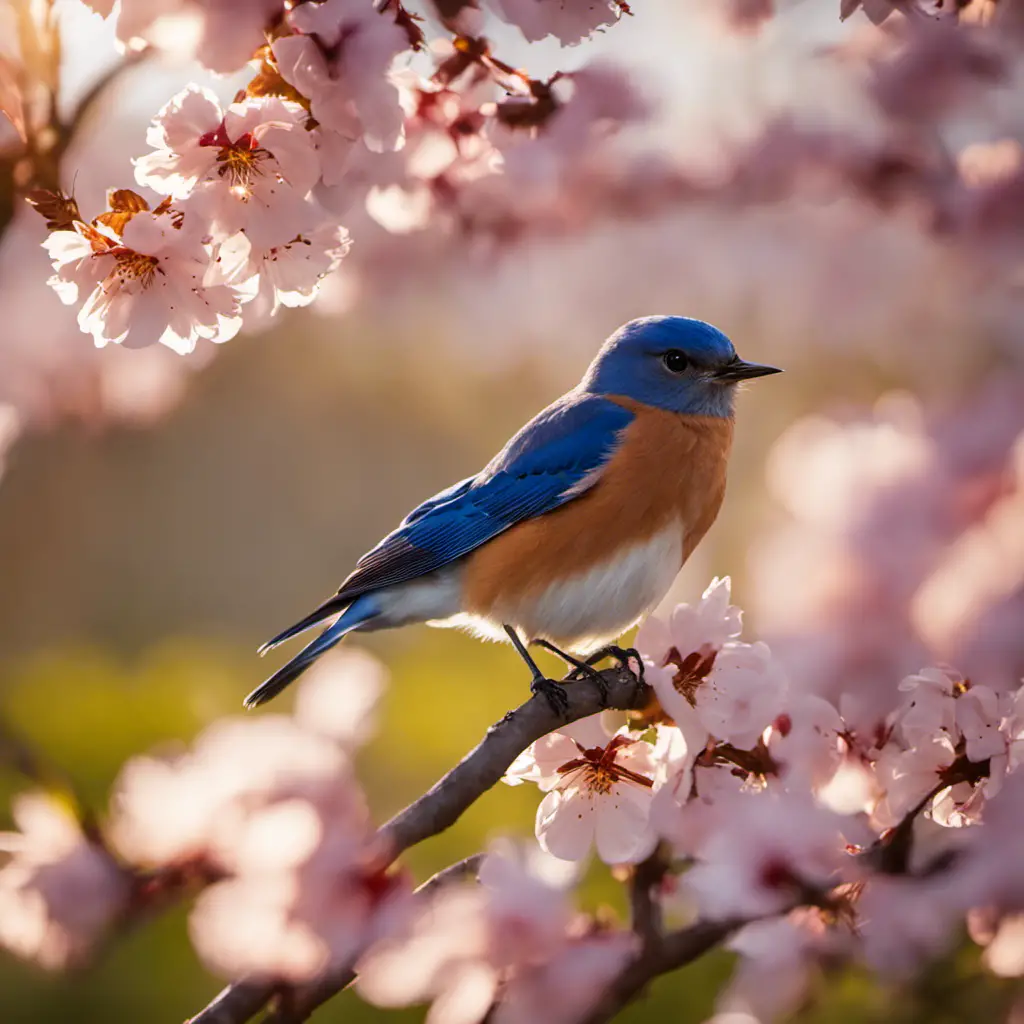
You can easily spot the Eastern Bluebird perched on a branch near your birdhouse. These beautiful birds, native to North America, are known for their vibrant blue feathers and orange chests.
Conservation efforts have been made to protect the Eastern Bluebird, as their populations have declined due to habitat loss and competition for nesting sites. Eastern Bluebirds are cavity nesters, meaning they build their nests in natural or man-made cavities. They prefer open habitats with scattered trees, such as meadows and farmlands.
To encourage their nesting habits, conservationists have installed nest boxes throughout their range. These nest boxes mimic natural cavities and provide a safe place for the birds to raise their young. By providing suitable nesting sites and protecting their habitats, conservationists hope to increase the Eastern Bluebird population and ensure their long-term survival.
Eastern Towhee

While walking through the forest, you might come across an Eastern Towhee scratching the ground for insects and seeds, and it’s a fascinating sight. The Eastern Towhee (Pipilo erythrophthalmus) is a medium-sized bird found in the eastern United States.
Here are three intriguing facts about their behavioral patterns and habitat preferences:
Distinctive Scratch Marks: Eastern Towhees have a unique way of foraging for food. They use their strong feet to scratch the ground, revealing insects and seeds hidden beneath the leaf litter. This behavior leaves behind distinctive scratch marks, which can be a telltale sign of their presence.
Shrubland Specialists: These birds have a preference for habitats with dense shrubs and undergrowth. They can be found in forest edges, thickets, and overgrown fields. The presence of shrubs and low vegetation provides them with ample cover for nesting and foraging.
Territorial Singers: Eastern Towhees are known for their loud and distinctive songs. Males often sing from elevated perches to establish and defend their territories. Their songs consist of a repeated phrase, ‘drink-your-tea,’ which can be heard throughout their preferred habitats.
Understanding the behavioral patterns and habitat preferences of the Eastern Towhee is key to conserving and protecting their populations in the wild.
European Starling
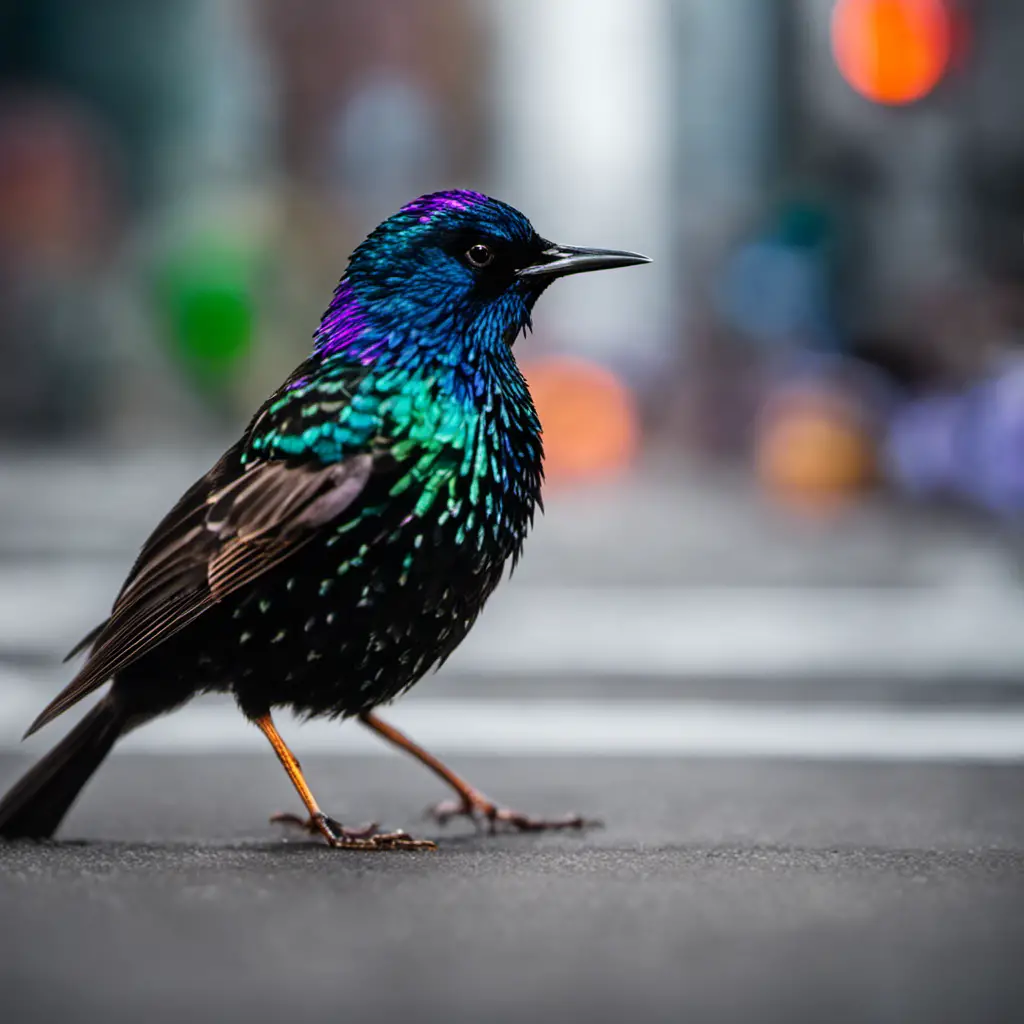
When it comes to invasive bird species in North America, the European Starling is one that you should be aware of. Originally introduced to North America in the late 1800s, the European Starling has rapidly spread across the continent, becoming one of the most abundant bird species in North America today.
The behavior patterns of the European Starling are highly adaptable, allowing them to thrive in a variety of habitats. They’re known to form large flocks, which can be detrimental to native bird populations. In terms of habitat preferences, European Starlings are commonly found in urban and suburban areas, where they nest in cavities such as tree holes and buildings.
Their ability to adapt to diverse habitats and their aggressive nature make the European Starling a formidable invasive species in North America.
House Finch

If you spot a House Finch in New York, it could be a sign that spring is on its way. These small, colorful birds are known for their vibrant plumage and melodious songs. Here are three fascinating facts about the breeding habits of House Finches:
Nesting Behavior: House Finches build cup-shaped nests using twigs, grass, and other plant materials. They often choose locations near human habitation, such as trees, shrubs, or even hanging baskets. This preference for urban environments is due to the availability of food sources and shelter.
Breeding Season: House Finches breed from late winter to early summer, with peak activity in spring. During this time, males display their bright red plumage and sing to attract mates. Females choose a mate based on these displays and the quality of the male’s territory.
Urbanization Impact: The impact of urbanization on House Finch populations has been both positive and negative. Urban areas provide abundant food sources, such as bird feeders and gardens. However, the loss of natural habitats and the presence of predators can negatively affect nesting success.
Understanding the breeding habits and the impact of urbanization on House Finch populations can help us appreciate and conserve these beautiful birds in our urban environments. Keep an eye out for these signs of spring and enjoy the lively presence of House Finches in New York.
House Sparrow
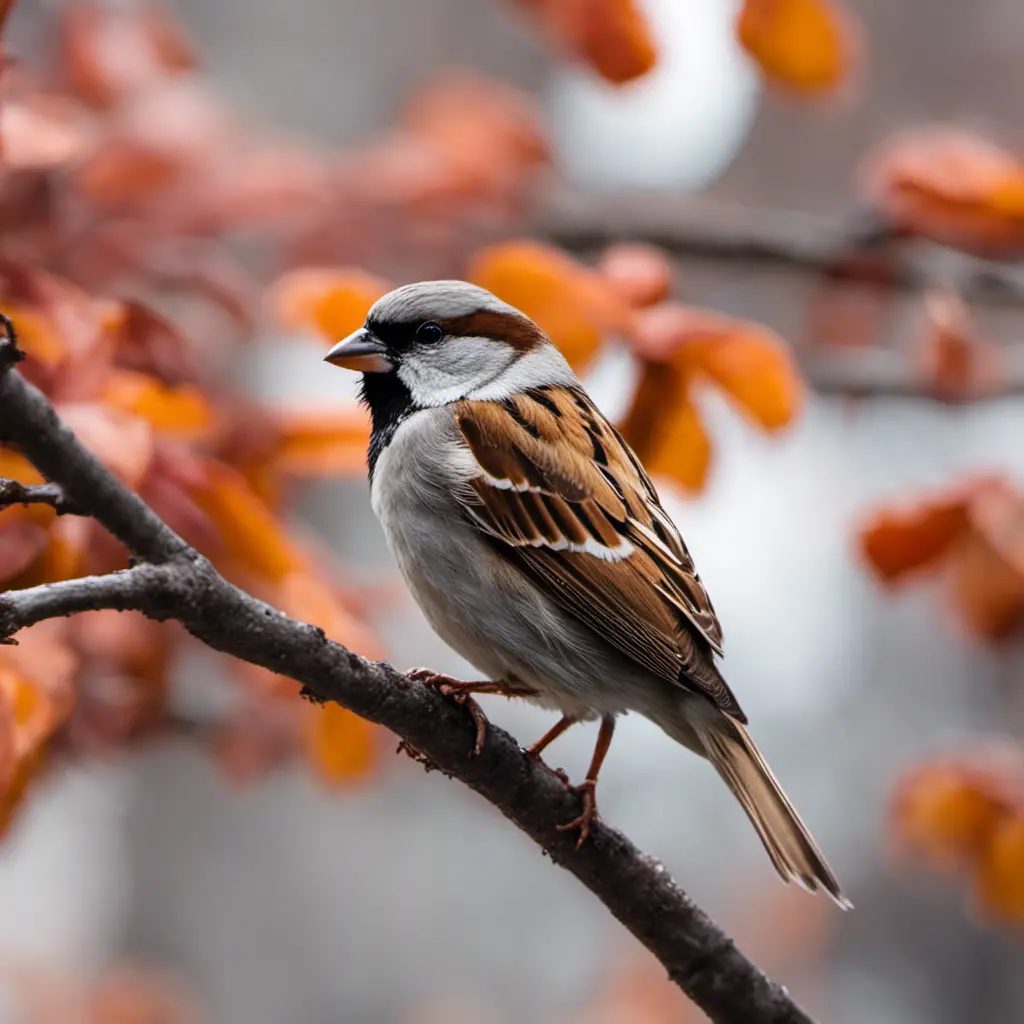
You should consider providing nesting boxes for House Sparrows in your yard, as they prefer to build their nests in cavities. House Sparrows, scientifically known as Passer domesticus, are small, social birds commonly found in urban and suburban areas across North America. They are known for their adaptability and tendency to form large flocks. House Sparrows exhibit interesting behavior patterns and have distinct habitat preferences. To better understand their preferences, here is a table summarizing their behavior and habitat choices:
| Behavior Patterns | Habitat Preferences |
|---|---|
| Nest in cavities | Urban areas |
| Form large flocks | Suburban areas |
| Feed on grains and seeds | Farmlands |
| Sparrows are social birds | Open habitats |
Mallard

Take a moment to observe Mallard ducks gliding gracefully across the pond as they preen their feathers. These beautiful waterfowl are fascinating creatures, with unique habitat and behavior patterns. Let’s delve into the world of mallards and explore the efforts being made to conserve their populations.
Habitat and behavior of mallards:
- Wetland habitats: Mallards are commonly found in wetlands such as ponds, marshes, and lakes.
- Nesting habits: Female mallards build nests on the ground, usually near water, using materials like grass and leaves.
- Feeding behavior: Mallards are omnivorous, feeding on a variety of plants, seeds, insects, and small aquatic creatures.
Conservation efforts for mallard populations:
- Habitat preservation: Protecting wetland habitats is crucial for mallard populations to thrive.
- Hunting regulations: Implementing sustainable hunting regulations helps maintain healthy mallard populations.
- Education and awareness: Increasing public knowledge about the importance of mallard conservation encourages active involvement.
Understanding the habitat and behavior of mallards, combined with conservation efforts, plays a vital role in ensuring the survival of these graceful ducks.
Mourning Dove

As you observe the Mourning Dove’s gentle cooing, you can appreciate the peacefulness of its song. The Mourning Dove, scientifically known as Zenaida macroura, is a medium-sized bird found in North America.
Caring for mourning doves involves providing them with suitable food, water, and shelter. These birds primarily feed on seeds, grains, and fruits, so offering them a varied diet can help ensure their health and well-being. Additionally, providing a shallow dish of water for drinking and bathing is essential for their hygiene.
Understanding the mating behavior of mourning doves is also crucial for their care. These birds form monogamous pairs and engage in a unique courtship display. The male will puff up his chest, coo softly, and bow to the female, often presenting her with twigs or other nesting materials.
Northern Cardinal

Spotting a vibrant male Northern Cardinal perched on a tree branch can be a breathtaking sight. These magnificent birds are known for their brilliant red plumage, contrasting beautifully against the green foliage. Here are three fascinating facts about the Northern Cardinal that will surely captivate you:
Habitat preferences: Northern Cardinals are commonly found in woodlands, gardens, and shrubbery. They’ve a preference for areas with dense vegetation, as it provides them with ample cover and food sources.
Breeding behavior: Cardinals are monogamous birds, meaning they mate for life. During the breeding season, males sing melodious songs to attract females. Once a pair forms, they work together to build a nest, usually in dense shrubs or low trees. The female lays a clutch of 3-4 eggs, which she incubates while the male provides food.
Popularity among birdwatchers: The Northern Cardinal is a beloved species among bird enthusiasts. Its striking appearance, beautiful song, and year-round presence make it a cherished sight in gardens and parks.
Northern Flicker
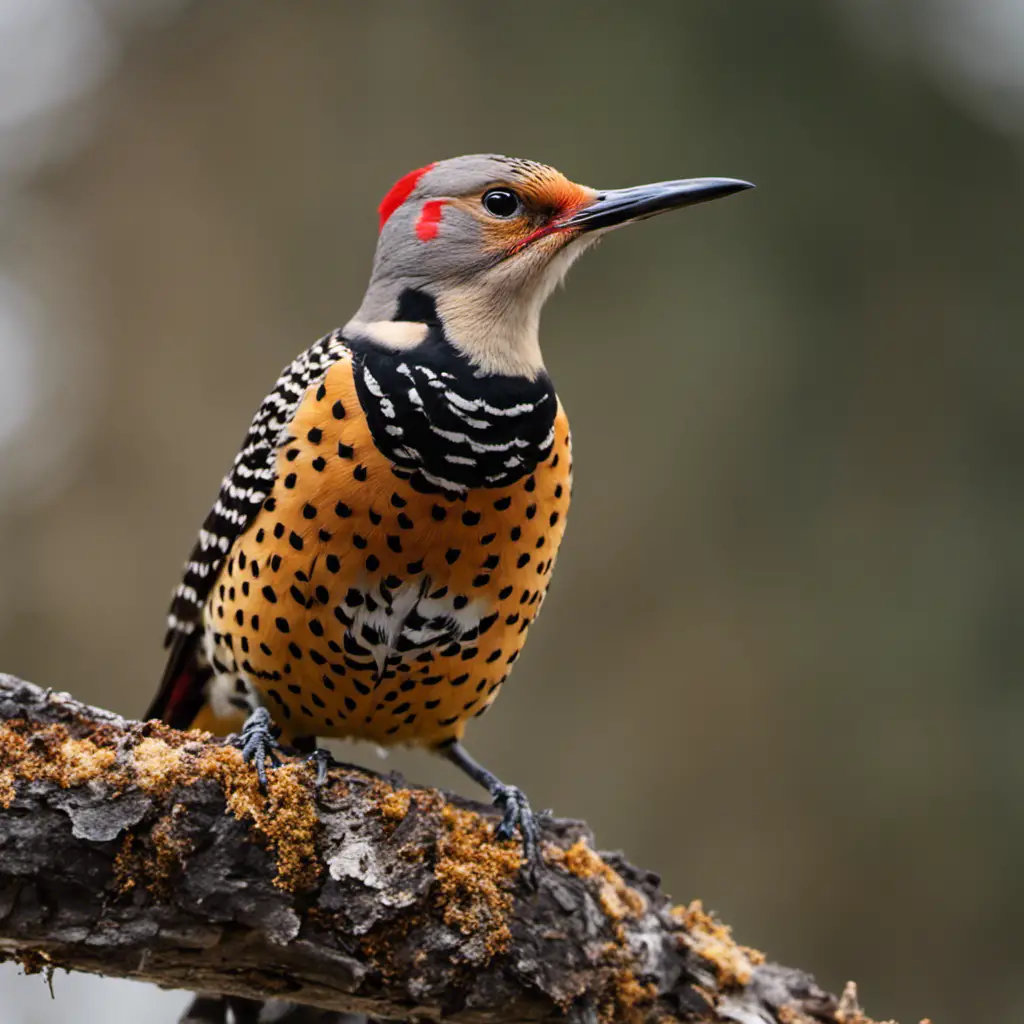
You might be surprised to learn that Northern Flickers are often seen excavating tree trunks for insects during the summer months. These medium-sized woodpeckers have distinct behavior patterns and habitat preferences that contribute to their unique foraging techniques.
Northern Flickers are primarily insectivorous, relying on their strong bills to extract ants, beetles, and other small invertebrates from the bark and wood of trees. Their behavior of excavating tree trunks is known as ‘anting’, where they create holes to access their prey. This behavior isn’t only a means of obtaining food but also serves as a territorial display and courtship behavior.
Northern Flickers can be found in a variety of habitats, including open woodlands, forests, and even urban areas with mature trees. Their preference for trees with decaying wood and open spaces allows them to thrive in diverse environments.
Red-bellied Woodpecker

During the summer months, you can often spot Red-bellied Woodpeckers foraging for insects in trees. These beautiful birds have distinct behavioral patterns and habitat preferences that make them fascinating to observe. Here are three key facts about Red-bellied Woodpeckers:
Behavioral patterns: Red-bellied Woodpeckers are known for their drumming behavior, which involves rapid and repeated pecking on tree trunks. This behavior serves multiple purposes, including communication, territorial defense, and foraging. They also have a unique feeding technique called ‘hitching,’ where they use their stiff tail feathers to support themselves while clinging to tree trunks.
Habitat preferences: Red-bellied Woodpeckers are adaptable birds that can be found in a variety of habitats, including forests, woodlands, and suburban areas with mature trees. They prefer areas with ample dead wood, as it provides nesting sites and a reliable food source of insects and tree sap.
Appearance and vocalization: Red-bellied Woodpeckers have a striking appearance, with a red cap on the back of their head and a pale belly with faint red wash. They also have a distinct call, often described as a rolling ‘churr’ or ‘chuckle’ sound, which they use for communication and to establish territory.
Understanding the behavioral patterns and habitat preferences of Red-bellied Woodpeckers can enhance our appreciation for these remarkable birds and their role in their ecosystem.
Red-tailed Hawk

If you look up, you can often see a Red-tailed Hawk soaring through the sky. These majestic birds are known for their impressive hunting behavior and unique nesting habits.
Red-tailed Hawks are skilled predators, using their sharp talons and powerful beak to capture their prey. They primarily hunt small mammals, such as mice and rabbits, but they’re also known to take birds, reptiles, and even insects. Their hunting strategy involves perching on high vantage points, scanning the ground for movement, and then swooping down to catch their prey.
When it comes to nesting, Red-tailed Hawks prefer to build their nests high up in trees, usually near open areas such as fields or meadows. The nests are large and made of sticks, and they’re often reused and added to each year. These nests can become massive, reaching up to three feet in diameter.
Red-tailed Hawks are known to be monogamous and will typically mate for life. Their nesting season begins in late winter or early spring, with the female laying two to three eggs that are incubated for about a month. Both parents take turns incubating the eggs and caring for the young. Once the chicks hatch, they’re dependent on their parents for food and protection for several weeks until they’re able to fly and hunt on their own.
The Red-tailed Hawk is a fascinating bird with its impressive hunting abilities and unique nesting habits, making it a truly remarkable species to observe in the wild.
Rock Pigeon
The Rock Pigeon is a common sight in urban areas, and its adaptability and resilience are what make it such a successful species.
Here are three reasons why the Rock Pigeon has thrived in urban environments:
Behavioral patterns: Rock Pigeons have a strong flocking instinct, which helps them find safety in numbers. They’re highly social birds, often seen gathering in large groups on buildings, ledges, and statues. This behavior allows them to share information about food sources and predators, increasing their chances of survival.
Habitat preferences: Unlike many bird species that rely on specific habitats, Rock Pigeons are extremely adaptable. They can be found in a wide range of urban environments, such as parks, rooftops, bridges, and even subway stations. Their ability to utilize various structures as nesting sites and food sources gives them a competitive advantage.
Resilience: Rock Pigeons have the ability to withstand harsh conditions and thrive in polluted environments. They’ve a high tolerance for pollution and can handle noise, dust, and other urban disturbances. This resilience allows them to persist in areas where other bird species struggle to survive.
Overall, the Rock Pigeon’s behavioral patterns and habitat preferences, combined with its resilience, have enabled it to successfully colonize urban areas and become a familiar sight in cities worldwide.
Song Sparrow
You can enhance your bird-watching experience by listening to the melodious singing of the Song Sparrow. This small passerine bird, scientifically known as Melospiza melodia, is a common sight across North America, including New York.
The Song Sparrow is known for its distinct song, which consists of a series of clear musical notes followed by a trill. Understanding the sparrow’s migration patterns can greatly increase your chances of spotting one. During the breeding season, Song Sparrows can be found in open habitats such as fields, marshes, and forest edges.
They construct their nests on the ground, often hidden in dense vegetation. These nests are typically made of grass, leaves, and twigs, providing a safe haven for their young. By studying the sparrow’s nesting habits, you can gain valuable insights into their behavior and ecology.
Tufted Titmouse
To get a better view of the Tufted Titmouse, try visiting your local park early in the morning when they’re most active. This small songbird can be found throughout the eastern United States, including New York. Here are three fascinating facts about the behavior patterns, habitat, and diet of the Tufted Titmouse:
Behavior patterns:
- The Tufted Titmouse is known for its distinctive call, a whistled ‘peter-peter-peter’ sound.
- They’re highly social birds and often seen in small groups, foraging together for food.
- These birds are curious and will readily investigate bird feeders and other objects in their environment.
Habitat:
- Tufted Titmice prefer deciduous forests and wooded areas, where they can find a mix of trees for nesting and foraging.
- They’re adaptable and can also be found in suburban areas with mature trees and bird feeders.
Diet:
- The diet of the Tufted Titmouse consists mainly of insects, seeds, nuts, and berries.
- They’ve a unique foraging behavior where they store food items in crevices or under bark for later consumption.
- These birds are frequent visitors to bird feeders, where they enjoy sunflower seeds and suet.
White-breasted Nuthatch
Watching the White-breasted Nuthatch’s acrobatic foraging is a delightful sight in the early morning. These small birds with their distinctive black and white plumage can be found in various habitats across New York. They are known for their unique behavioral patterns and habitat preferences.
The White-breasted Nuthatch is a cavity-nesting species, often choosing tree cavities or nest boxes for breeding. They are skilled climbers, using their strong bills to excavate holes in trees. Their diet consists mainly of insects, seeds, and nuts, which they expertly extract from crevices using their long, slender bills. They are also known to store food for later use, tucking seeds and nuts into tree bark.
To better understand the White-breasted Nuthatch’s behavioral patterns and habitat preferences, let’s take a closer look at the table below:
| Behavioral Patterns | Habitat Preferences |
|---|---|
| Vertical climbing | Deciduous forests |
| Head-first descent | Mixed woodlands |
| Food caching | Open woodlands |
| Territorial | Urban parks |
As we can see, these birds exhibit unique behaviors such as vertical climbing and head-first descent. They prefer habitats with deciduous or mixed woodlands, open woodlands, and even urban parks. This versatility allows them to adapt to various environments and thrive in different parts of New York.
Wild Turkey
Have you ever encountered a Wild Turkey while exploring the forests of New York? These magnificent birds, native to North America, have made a remarkable comeback in the state. Here are three fascinating aspects of their habitat and behavior:
Habitat: Wild Turkeys in New York can be found in a variety of habitats, including forests, woodlands, and open fields. They prefer areas with a mix of trees for roosting and open spaces for foraging.
Behavior: Wild Turkeys are social animals and live in flocks, called gobbles. They communicate with each other using a variety of vocalizations, including the famous gobble. During breeding season, male turkeys display their impressive plumage and perform elaborate courtship displays to attract females.
Conservation Efforts: Due to habitat loss and overhunting, Wild Turkeys faced a decline in the past. However, through successful conservation efforts such as habitat restoration and regulated hunting, their populations have rebounded significantly.
Understanding the habitat and behavior of Wild Turkeys in New York, as well as supporting conservation efforts, is crucial in preserving these remarkable birds for future generations to enjoy.
Wood Duck
Do you know how the Wood Duck gets its vibrant colors and patterns, and why they’re considered one of the most beautiful waterfowl species?
The Wood Duck, scientifically known as Aix sponsa, is renowned for its stunning appearance. The male Wood Duck boasts a mesmerizing combination of iridescent green, purple, and white feathers, while the female exhibits a more subtle plumage with shades of brown and gray.
These vibrant colors and patterns are a result of both genetic factors and the duck’s habitat. Wood Ducks thrive in wetland areas with an abundance of trees and shrubs, which provide them with suitable nesting sites. They’re cavity nesters, meaning they lay their eggs in tree cavities or nest boxes.
This unique breeding behavior, combined with their habitat preservation efforts, has contributed to the survival and beauty of this remarkable waterfowl species.
What Birds of New York are Preyed Upon by the Most Common Reptiles?
In New York, common reptiles like snakes and turtles prey on birds such as pigeons, sparrows, and robins. The common reptiles in New York are opportunistic predators and will take advantage of any available bird species for food. These reptiles play a crucial role in maintaining a balance in the ecosystem.
Frequently Asked Questions
What Is the Average Lifespan of a Blue Jay?
On average, a blue jay’s lifespan is around 7 years. Their behavior and diet play a role in determining their lifespan. Blue jays are known for their intelligence, adaptability, and fondness for acorns.
How Do Carolina Wrens Build Their Nests?
Carolina wrens demonstrate fascinating nest-building techniques. They exhibit behavioral adaptations during construction, carefully selecting materials and using their beaks to create intricate structures. Their nests are a testament to their resourcefulness and survival instincts.
What Is the Migration Pattern of the Dark-Eyed Junco?
The dark-eyed junco has a migratory pattern that varies across different regions. Bird banding research has helped to track their movements and understand their breeding habitats.
Do European Starlings Have Any Natural Predators in New York?
European starlings in New York face predation effects, as they have natural predators. This predation plays a role in population control, as it helps regulate the starling population and maintain a balance in the ecosystem.
How Can I Attract Wood Ducks to My Backyard?
To attract wood ducks to your backyard, create a bird friendly environment. Provide a suitable nesting box near a water source, such as a pond or stream. Plant native vegetation for cover and install bird feeders with appropriate food.
Conclusion
In conclusion, the diverse array of bird species found in New York showcases the rich avian biodiversity of the region.
The American Robin, Black-capped Chickadee, Blue Jay, Canada Goose, Carolina Wren, Tufted Titmouse, White-breasted Nuthatch, Wild Turkey, and Wood Duck are just a few examples of the fascinating bird species that call this state home.
Studying and preserving these birds is crucial for maintaining the delicate balance of ecosystems and ensuring their continued presence in New York’s natural environment.

An avid ornithologist, zoologist and biologist with an unwavering passion for birds and wild animals.
Dr. Wilson’s journey in ornithology began in childhood and led him to obtain a Ph.D. in Ornithology from the prestigious Avian Research Institute. He has worked closely with renowned experts in the field and conducted extensive research and field studies globally.


